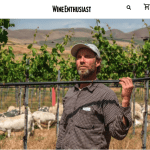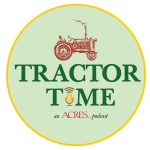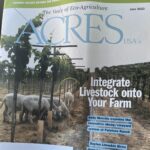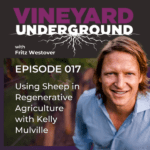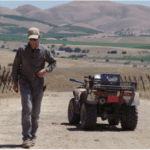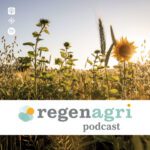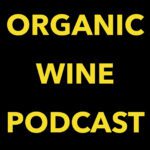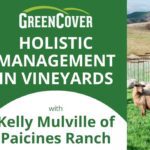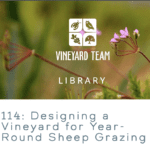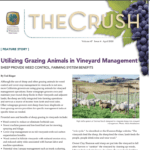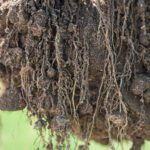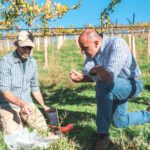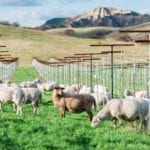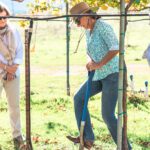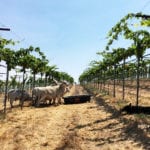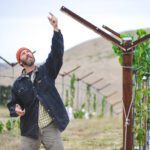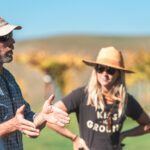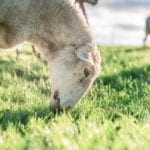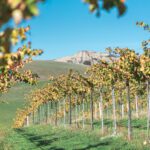The Paicines Ranch Vineyard has been designed and is being tended to encourage ecosystem health and flourishing biodiversity while producing exceptional quality wine and food.

Overview
What if it were possible to design a vineyard that required very few inputs or human labor, produced good yields of high quality grapes, produced animal protein, improved soil health, sequestered carbon, increased diversity, and made a good financial return? This was the vision developed by holistic management educator and viticulturist, Kelly Mulville.
The vineyard at Paicines Ranch is a uniquely designed polyculture with a partial overhead trellis system that allows for grazing of the vines throughout the year. This eliminates the need for tillage, mowing, herbicides, suckering, hand weeding and encourages high biodiversity of plants, insects, birds and soil biology.
How it Works:
CANOPY
High up on the trellis system, the lush vine leaves and fruit are mostly out of reach for grazing sheep. The thick canopy keeps the vineyard cooler on hot days, reduces frost damage on cool nights, and provides partial shade for sheep, grapes, people, and wildlife.
TALL VINES
Growing the vines taller allows sheep to do our work while they get to do what they love - browse suckers and shoot tips. The higher trellis system also allows easier access in all directions under the wires for sheep and people–which also makes it easier on the bodies of those humans tending to and harvesting the grapes!
SHEEP
The sheep are our partners in creating a healthy ecosystem in the vineyard. They cycle nutrients, browse suckers and shoot tips, which reduces the need for outside fertilizer inputs, tractors and manual labor, and provides an additional source of profit. Plus they’re fun to work with!
Unlike traditional vineyards, our system is designed so that the sheep can graze at anytime of the year -- even during the growing season.
FRUIT
The wine grapes from our initial harvests are proving to be nutrient dense while producing higher yields. Their quality has inspired us to reduce or eliminate the need for outside inputs and chemicals.
VINEYARD FLOOR
Living plants and mulch covers the vineyard floor soil throughout the year, keeping the ground cool and moist, thus improving habitat for soil life. The diverse plant cover provides grazing forage, nutrient cycling, carbon sequestration, habit and food for insects, birds, and rodents.
All these benefits without tillage.
VINEYARD SOIL
Through key soil health principles – keeping the soil covered, keeping living plants and roots, growing biodiversity, eliminating tillage, and integrating the sheep in the vineyard, the soil life is continuously improving and flourishing with a high capacity to capture and hold water.
Design to Fruition

Imagine if you could design a vineyard that required very few inputs or human labor, produced good yields of high quality grapes, produced animal protein, improved soil health, sequestered carbon, increased diversity, and made a good financial return? This was the vision presented by holistic management educator and viticulturist, Kelly Mulville, at an EcoFarm presentation in January, 2013. His presentation was based on a trial that he had done in California between 2008 and 2010.
Paicines ranch owner, Sallie Calhoun, was intrigued by the vision and the possibility. In the 1960's vineyards on the ranch were part of what was then the world's largest varietal vineyard in Paicines. Sallie had considered partnering with conventional grape producers on a lease basis, but was not comfortable with the bare ground, erosion, repeated tillage, and spraying common in CA vineyards today. Kelly's vision was something altogether different, and the opportunity to design a vineyard from the beginning to be grazed by sheep year-round as a polyculture growing healthy soil was an idea too compelling to walk away from.
Kelly joined the Paicines Ranch team in early 2014 and began the vineyard design. The intention is that once the vineyard is planted, most of the work normally done by tractors will instead be done by sheep, and the ground will not be tilled again during the life of the vineyard. The 25-acre site was a conventional vineyard from 1965-1995 and has been grazed by cattle in the years since. Site prep consisted of installation of irrigation, some leveling and ripping, and installation of the newly designed high trellis system. Soil prep included a light compost application, the planting of cover crops, and high stock density grazing by sheep and cattle from late 2014 until planting of the 12.5 acres of phase 1 in the spring of 2017. The final 12 acres were planted in early summer 2020.
Since that first planting in 2017, many ideas have been tried and much has been learned. The planting was split into two phases so that learnings from phase 1 could be incorporated into phase 2. Changes included trellis modifications and planting ungrafted rootstock. In order to keep the grapes and most of the leaves out of reach of the sheep during the summer, the trellis is much higher than in a conventional vineyard. This has meant learning how best to train the vines and how to get them tall as quickly as possible. There have also been major challenges with ground squirrels.
We are still on a rapid learning curve, but the results are encouraging so far. We have seen increased soil carbon on the 25-acre site and the appearance of a variety of native plants in the vineyard. The first warm season grazing happened in summer of 2021, and that September we completed the first commercial harvest for the vineyard. This included 3.6 tons of grenache, 1/2 ton of verdejo and 1/4 ton of assyrtiko. In Spring 2022, Megan Bell of Margins Wine released the first wines made with our grapes.
We look forward to continuing to learn and watch the vineyard ecosystem develop.

Kelly Mulville
For the past 25 years Kelly has managed and consulted with vineyards, farms and ranches throughout the western USA, Spain and Australia. His focus is on combining experience in farming and viticulture with holistic management in order to design and manage more ecologically, socially and economically sound farming practices. This usually involves a considerable amount of help from livestock. Kelly regularly does presentations at numerous conferences throughout the United States, and in 2012 he was sponsored by government and wine industry organizations to give presentations and workshops on extended-season vineyard grazing throughout Australia and New Zealand. His studies include Ecological Horticulture at UC Santa Cruz and Holistic Management with Allan Savory.
Kelly has been vineyard director at Paicines Ranch since 2014 and does design/advising work for vineyards.
To learn more about Kelly and his work, check out one of these:
Organic Wine Podcast: Regenerative Grazing-Based Viticulture at Paicines Ranch with Kelly Mulville
John Kempf: Regenerative Ag Podcast with Kelly Mulville
Green Cover Seed: Holistic Management in Vineyards with Kelly Mulville
New York Times / The Pour by Eric Asimov: Are Sheep a Crucial Ingredient for Vineyards and Ecosystems?
Some words from our friends...
[The ideal version of our vineyard] "would enable grazing during spring and summer to better control summer grasses and incorporate organic nitrogen inputs nearly year-round. It would need a large off-farm grazing area for the rest of the year. Paicines Ranch in California is pretty close to perfect." [read Regenerative Viticulture Q&A here]
– Dudley Brown, Inkwell Wine - McLaren Vale Australia
"The early results are encouraging. I tasted an assyrtiko and a verdejo during a visit to Paicines earlier this year and found both to be fresh, energetic and deeply textured. The assyrtiko in particular was striking, reminiscent of the stony citrus and herbal flavors of a wine from Santorini but kissed by a little California sun." [article here]
– Eric Asimov, wine critic, New York Times
"I was incredibly impressed to see what my friends at Paicines Ranch have achieved as far as bringing real vibrancy to the site they are farming. The seamless integration of livestock in their vineyard is not just an abstract biodynamic principle, but the center piece of their effort." [@RandallGrahm]
– Randall Grahm, Bonny Doon Vineyard
"Kelly has been obtaining impressive results by merging his experience in viticulture with his understanding of Allan Savory’s holistic grazing management techniques. His approach to extended-season vineyard livestock grazing and other ecological practices continue to capture an audience of vineyard managers around the globe." [podcast here]
– John Kempf, Advancing Eco Agriculture & Regenerative Agriculture Podcast
The People Who Make It Happen
The Paicines Ranch Vineyard takes a village of passionate people working together to create abundance. From the initial vision and design of the vineyard to the daily reciprocal relationship with the land, from composting, seeding, grazing with cows and sheep, monitoring our efforts, building and maintaining the structure and facilities, capturing rain and sunlight, hosting tours, events, wine tastings, and walks... we see the vineyard as a place where all of our collaborative teamwork comes together in a great adventure!
Here are some of these folks, who invest their energy and love daily into the vineyard:
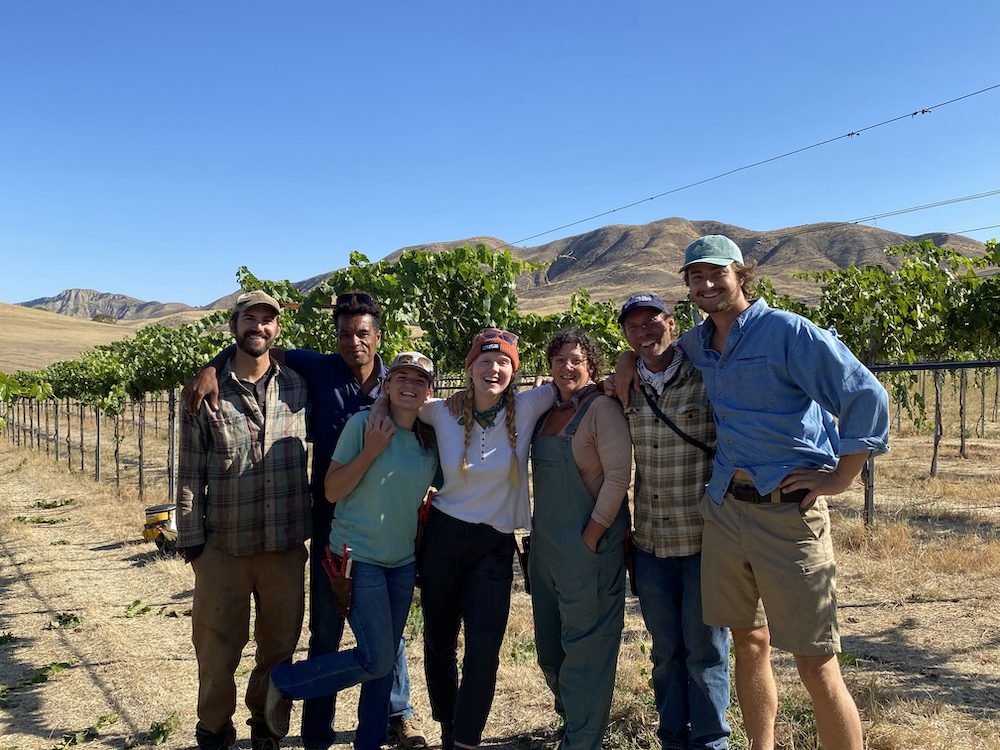
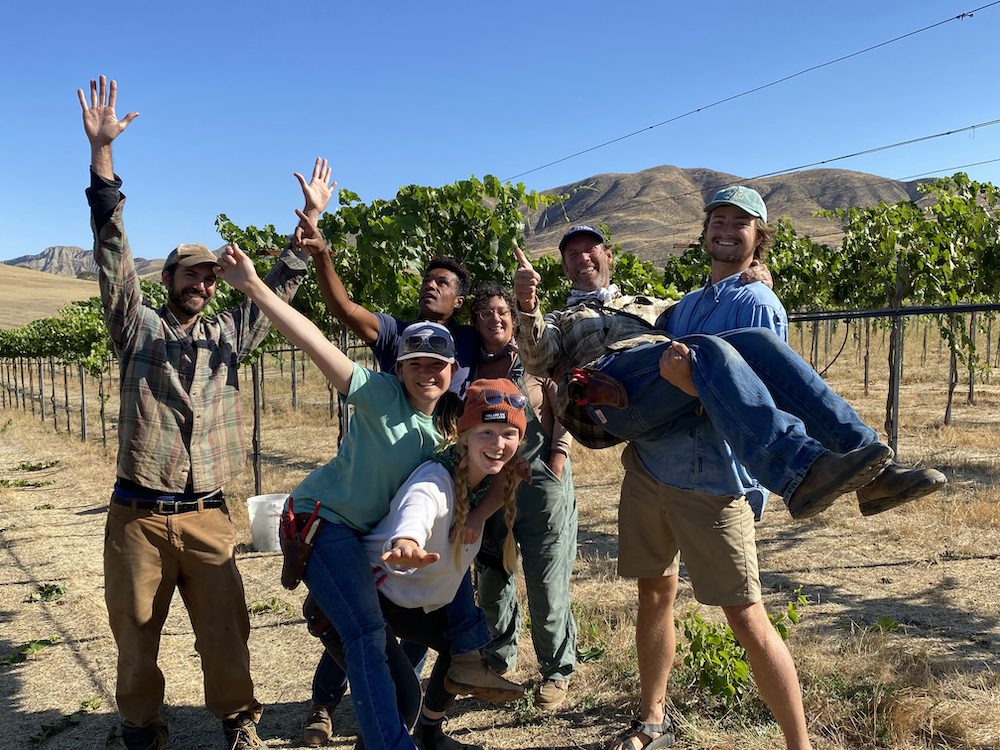


Monitoring for Biodiversity
Biodiversity is the learned result of millions of years of evolution, life’s direct response to shifting environmental conditions on Earth. As climate change accelerates, biodiversity is key to our resilience. Rather than simplify our agroecosystems by excluding wildlife and spraying pesticides or herbicides, we choose to farm with nature. For this reason we are collecting data on the populations of plants, birds, insects and soil microbes that inhabit the vineyard and play a critical role as vital pieces of a complex agroecological system. Insects, for example, are not only pollinators but also predators of pests, decomposers of waste and the foundation of many wild food chains - providing fertility, organic matter inputs and water holding capacity to our soils.
The following information highlights our findings, from the ground up, as we seek to demonstrate this ecologically aligned approach to managing vineyards:

Soil Organic Matter - Between 2014 and 2021, soil organic matter (SOM) percentage has increased 66% (from 1.5% to 2.5% SOM on average) in the topsoil -- between the soil surface and 1.3 feet (40cm) to 2 feet (60cm) deep. This benefits water retention, atmospheric carbon sequestration and helps to support the foundation of a healthy ecosystem.
Soil Microbes - Soil microbial communities have become more complex and diverse, resulting in 10% more bacterial and fungal species than in neighboring conventional vineyards.
Plants - Over 35 plant species grow in the understory of the vineyard, providing diverse resources and habitat both below- and above-ground.
Insects - Insect abundance is over five times greater than a neighboring conventional vineyard, according to a 2021 study. Beneficial predator and parasitoid insects were two to three times more abundant than in the conventional vineyard, while pests like herbivorous and sap-sucking insects were at the same levels without the use of pesticides.
Birds - Over 60 bird species visit the Paicines Ranch vineyard, including bald eagles, prairie falcons and endangered tricolored blackbirds. The latter were regularly foraging in the vineyard in spring 2022 to feed their nesting chicks.
Winemakers We Love!
We look for winemakers who share our vision and values when deciding who to collaborate with. Here are the talented folks we are currently partnering with:
Megan Bell | Margins Wine
We're thrilled to be working with Megan Bell of Margins Wine as our first winemaker partnership.
Margins Wine produces low-intervention wines using grapes from underrepresented regions, vineyards, and varietals. Margins is part of the growing movement in California to make wines from vineyards farmed organically or in organic conversion using minimal additives during the winemaking process, thereby showcasing the vineyards the grapes came from.
In Spring 2022 Margins released the first wines made with Paicines Ranch Vineyard grapes.
🍇 Megan is using Paicines Ranch Grenache, Verdejo and Assyrtiko.
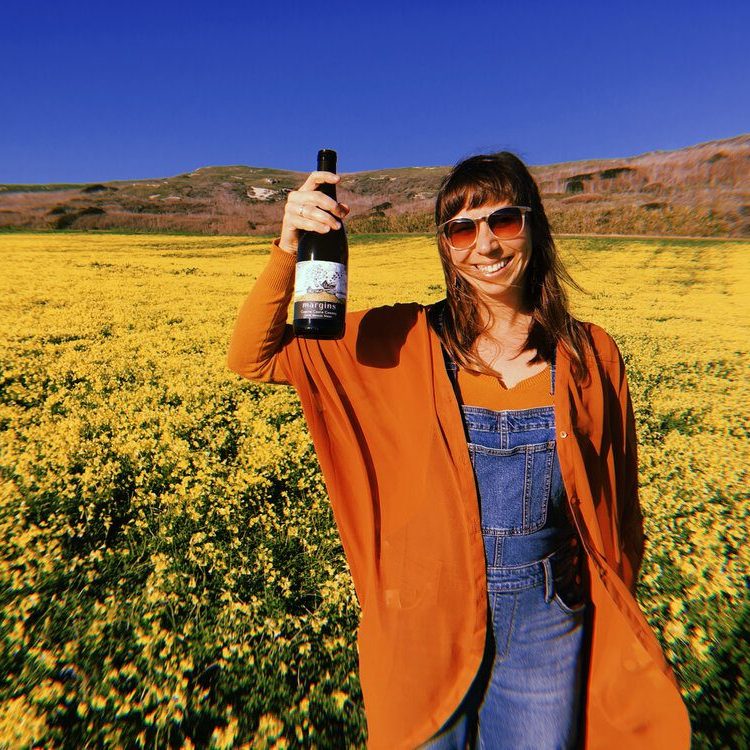
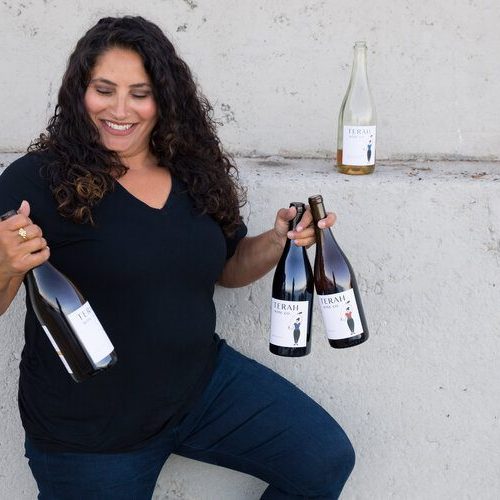
Terah Bajjalieh | Terah Wine Co.
“At Terah Wine Co we choose to work with organic, and biodynamic vineyards. We currently purchase fruit from independent growers. Specifically, we want to work with growers that care about the environment, the land, and the people they work with. The belief is that farming greatly dictates overall wine quality, which is always the focus for sourcing. The goal is to find unique microclimates and vineyard sites that are capable of showcasing outstanding varietal typicity and are capable of producing expressive, structured, balanced wine.”
🍇 Terah is using Pacines Ranch Grenache, Syrah and Verdejo.
Angela Osborne | A Tribute to Grace
"Angela Osborne moved to California in 2006, with the dream of making Grenache. Originally from New Zealand, where the climate is believed too cool for Grenache, she chose the abundant sunshine of Santa Barbara County to make her first wine. Named after her Grandmother, A Tribute to Grace Wine Company was founded in 2007, and is based in Los Alamos, CA. Winemaking focuses entirely on Grenache, with eight single-vineyard offerings, a Rosé of Grenache and a SBC blend."
We can't wait to try Angela's first release of wine made with Paicines Ranch grapes!
🍇 Angela is using Pacines Ranch Grenache.
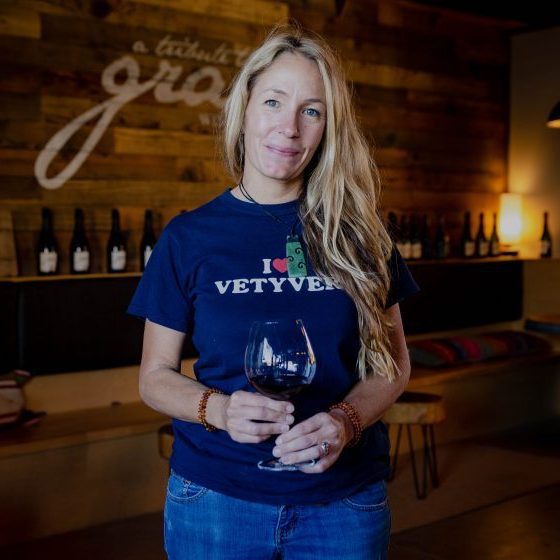
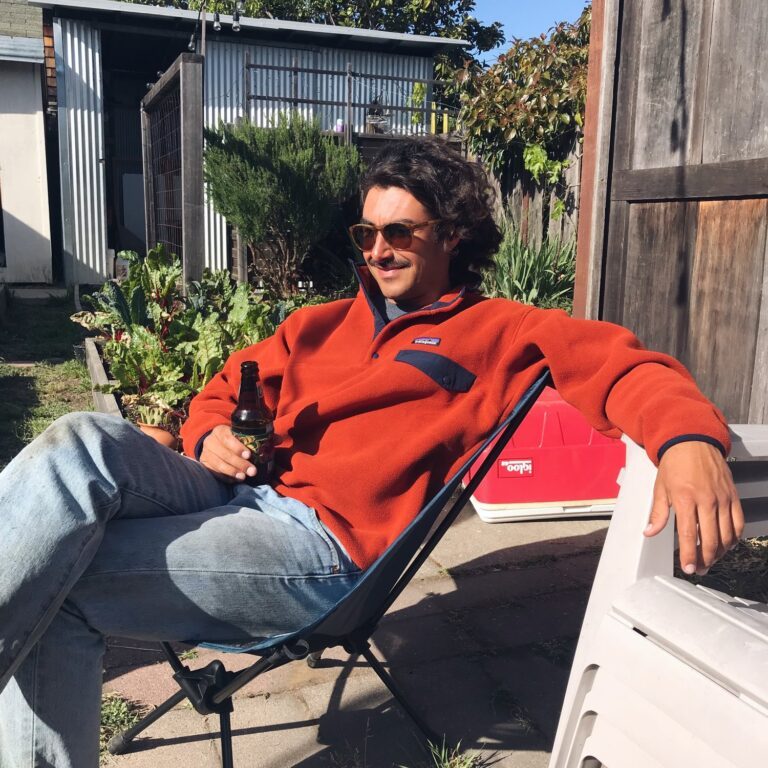
James Jelks | Florèz Wines
"By utilizing traditional, artisanal, and elemental practices we create one of a kind wines for those who take interest . Our production is small and our practices meticulous. We go out our way to do things exactly how we feel will best allow the wines to express distinct personality. The fruit is the most important part of the process and it is foundational that we work with good vineyards grown in harmony with their terroir."
We're eager to taste James' first release of wine made with Paicines Ranch grapes!
🍇 James is using Pacines Ranch Picpoul Blanc.
Tara Gomez & Mireia Taribo | Camins 2 Dreams
"Camins 2 Dreams represents the routes and paths we have followed to achieve our dreams. C2D was founded in 2017 by Tara Gomez and Mireia Taribo, who are a team of two winemakers. Their philosophy is to make hand-crafted, terroir-driven wines that are fermented with natural yeast and use minimal intervention in the winery, with only minimum amounts of S02 at bottling. Their wines are unfined and unfiltered. They believe that wine is made in the vineyard and they source fruit from vineyards that share the same values of respect for the land and their workers. They work exclusively with organic, biodynamic, and regenerative vineyards."
We can't wait to try their first release of wine made with Paicines Ranch grapes!
🍇 Tara and Mireia are using Pacines Ranch Mencía and Carignan.
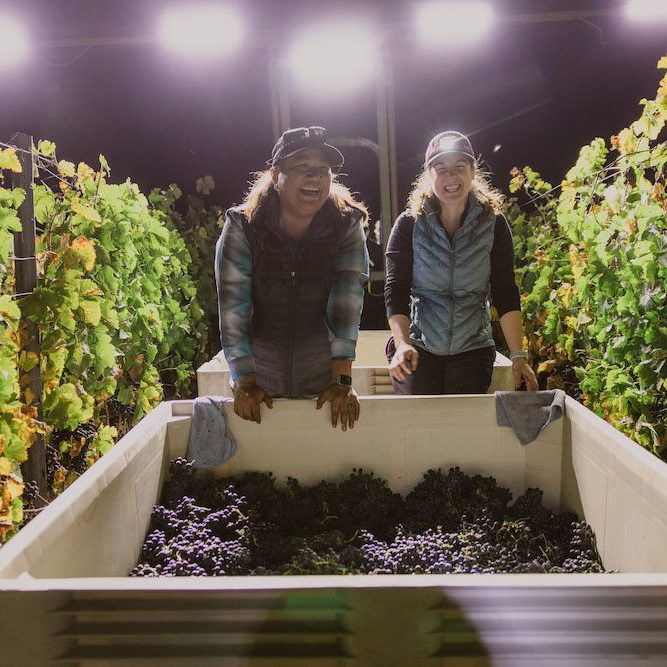
* * Watch the Magic Happen * *
Press & Media
Resources
> Watson Training System for Bunch Wine Grapes
> Virtual Viticulture Academy’s Grower Guides with videos and resources for grapevine pruning, nutrient management, and vine training
> Nutrient standards for leaf blades and petioles
> Kelly's article in The Australian & New Zealand Grapegrower & Winemaker on on modifying an existing vineyard for post leafing grazing
> Podcast interview of Kelsey Brewer about his research on vineyard grazing during the dormant season: How Grazing Sheep Can Benefit Your Vineyard
> Plant sap analysis at NEWAGE Laboratories

